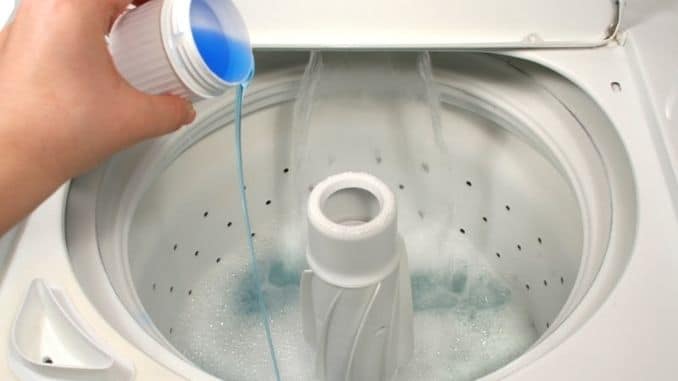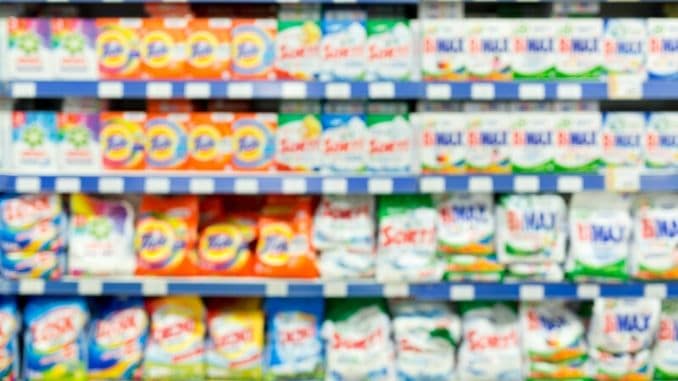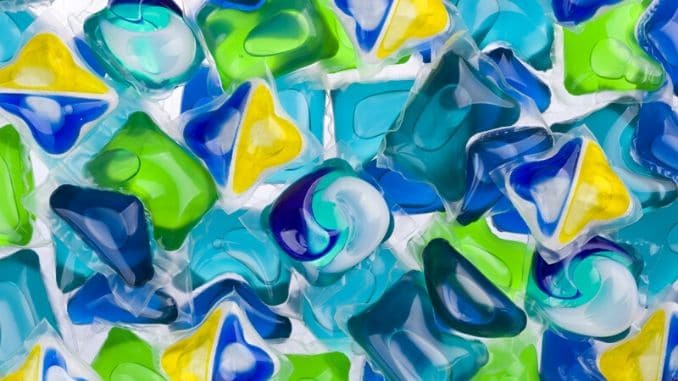
It’s a Saturday. You toss some laundry detergent in the machine, throw in a load of clothes, press the “start” button and get on with your day. A little later, you toss the clothes into the dryer. The following week, you pull them fresh from your closet or dresser drawer and put them on. The clothes feel good. The smell nice and seem clean, so what’s the worry?
Laundry detergent used to be pretty basic. However, during the past decade or so, innovation has hit laundry products the same way it has most every other product in our lives. Today’s detergents don’t just clean, but they also get rid of stubborn stains, brighten whites and colors, soften fabrics, discourage wrinkling and leave behind a lasting fragrance.
It’s not magic that creates these effects, but chemicals, including sulfates, phosphates, formaldehyde, enzymes, fragrances and more. Are these ingredients we should be concerned about, particularly because they come into contact with our skin day in and day out?
How Does Laundry Detergent Work?
You throw your clothes in the washing machine, add a little detergent and, with a little shake and rotation, they come out clean. But how exactly does that happen?
Today’s detergents have a full array of chemicals that contribute to the cleaning process, but it helps to begin with the basics: the cleansers and water conditioners.
The majority of the detergents you find on the market today are made up mostly of water conditioners. These help “condition” the water, separating out calcium, magnesium and other minerals that typically exist in tap water so that they don’t interfere with the cleaning process. In areas where the water is “hard,” there are even more of these metals and minerals in the water, which is why you often have to use more detergent.
The chemicals that make up these conditioners vary depending on the detergent and time. Older detergents used sodium triphosphate. However, after it was discovered that it was causing algae overgrowth in our waterways, it was replaced with other chemicals, most commonly sodium carbonate.
The other main ingredients in detergents are the cleansers or “surfactants,” short for surface active agents. These are the main ingredients that lift dirt and stains away from the clothing. One end of the surfactant molecule is attracted to the grime and the other to the water so, while one end is grabbing onto that grease and dirt on your shirt, the other end is pulling it away toward the water.
While your washing machine is twisting back and forth, these chemicals grab onto and remove stains from your clothes, after which they swim happily around in the water until it drains. They’ve then washed away, leaving your clean clothes behind.
These chemicals make up the most of your detergent, but then there are a number of other chemicals involved that either assist in the cleaning process or add other benefits like brightening and softening.
What Are the Other Chemicals in Laundry Detergents?
Other chemicals that are typically found in laundry detergents include the following:
- Bleaches to help whiten, remove stains and brighten colors.
- Enzymes to help break down tough food stains so that they can be removed by the surfactants.
- Brighteners to make the clothes look whiter or brighter to the human eye. These don’t change the brightness of the fabric but mask the yellow shade that can make clothes look old or dingy.
- Polymers to prevent soils from resettling on the clothes after the surfactants remove them.
- Perfumes or fragrances to leave behind a nice scent.
- Dyes to make the detergent a certain color.
- Fillers to help dilute and distribute the rest of the ingredients.
How many of these chemicals are in a particular detergent depends on the type of detergent you buy and often on where you live. Detergents in Western Europe and North America typically have more surfactants and more of these other chemicals than those sold in Asia, Africa or South America. The more chemicals you have, the more expensive the detergent is, so manufacturers make their detergents based on what customers want and what they can pay for.
Are the Chemicals in Laundry Detergent Toxic?
After discovering that the triphosphate in detergents could damage the environment, many people became concerned about the other ingredients too. Are they harmful to our soils and waterways? What about people with sensitive skin?
Below is a list of some of the most common chemicals found in detergents today, with a discussion on the potential toxicity of each.
Sulfates
Sulfates like sodium lauryl sulfate (SLS) and sodium laureth sulfate (SLES) are the most common surfactants used in laundry detergents as well as in shampoos, body washes, toothpaste and more. They remove dirt and grime from your clothes, and they also work as foaming agents in the wash.
At high concentrations, these chemicals are known to be irritating to the eyes and respiratory passages and can also be irritating to sensitive skin, though that depends on what other ingredients are present in the formula. Some conditioning ingredients can counteract any irritating effect that the sulfates may have.
There is some evidence that sulfates could be toxic to human health. Some consumers are concerned about cancer, but major health organizations — including the International Agency for Research on Cancer (IARC), U.S. National Toxicology Program, California Proposition 65 list of carcinogens, U.S. Environmental Protection Agency and the European Union — do not classify sulfates as carcinogens.
These chemicals can be absorbed through the skin when applied topically, so consumers worry that wearing their clothes every day might contribute to absorption. Studies show, however, that any sulfates that are absorbed are metabolized quickly by the liver and excreted through the urine.
Sulfates are moderately toxic to aquatic life, however. Most solutions dilute them down to the point that when they reach waterways, they are mostly degraded. This does remain a minor environmental concern.
Phosphates
Phosphates help remove hard-water minerals to make detergents more effective but, when released into the environment, can stimulate the growth of algae. After the algae bloom and die, they release toxins that deplete waterways of oxygen, literally suffocating aquatic life.
Many states have banned their use, and most laundry detergents now advertise themselves as “low-phosphate” or “phosphate-free.”
1,4-Dioxane
1,4-Dioxane (diethylene dioxide, diethylene esther or dioxan) is a chemical that is classified as a carcinogen, but manufacturers don’t purposely add it to their formulas. Instead, it’s often formed as a byproduct or contaminant of the manufacturing process, created when manufacturers use ethylene oxide as part of a process called “ethoxylation” that makes harsh ingredients milder.
There is also evidence that 1,4-dioxane may be toxic to the kidneys, liver, central nervous system and respiratory system, and it is a known groundwater contaminant.
Unfortunately, dioxanes aren’t listed on the product label, so it can be difficult to know if they are in your detergent. A 2010 study by the Green Patriot Working Group (GPWG) and the Organic Consumers Union (OCU) found that all of the major brand-name laundry detergents contained 1,4-dioxane, with Proctor and Gamble’s products containing the highest amounts.
Of all the “natural” brands tested, only two contained 1,4-dioxane and at lower levels than the conventional brands.
NPE
Nonylphenol ethoxylate (NPE) is an inexpensive surfactant that is a known “hormone-disruptor,” which means that it can mess with the endocrine system in both humans and animals. More specifically, it acts like estrogen in the body, which can create detrimental health effects.
Studies have found that when rainbow trout are exposed to NPE. It affects their gender, causing them to become part male and part female. A U.S. Geological Survey found metabolites of NPE in more than 61 percent of tested streams in the U.S.
We don’t know yet whether these chemicals may affect human health. There is some evidence that they may cause developmental problems and miscarriage.
NPEs have already been banned in Canada and Europe, and Walmart has asked manufacturers to phase out these ingredients. Many large manufacturers, including Proctor & Gamble and Unilever, have announced that they do not use NPEs.
Fragrances and Dyes
Companies can protect their fragrances as “trade secret,” which means they don’t have to reveal the chemicals used to create that fresh scent. The solution may contain many chemicals to create the final fragrance . There’s no way for consumers to know what these are.
The main concern with fragrances is allergic reactions. They are the most common sensitizing ingredient,. Whichmeans people can grow more sensitive to them over time, developing allergies and asthma with increased exposure.
Dyes are added to detergents to color them and make them more appealing to consumers. They are similar to fragrances in that they can lead to allergic reactions.
Optical Brighteners
These chemicals are added to detergents to make clothes look brighter and whiter. But they don’t do anything to the clothes themselves. Instead, they adhere to the clothes, absorbing ultraviolet light and reflecting blue light to make the clothes “appear” brighter and whiter to our eyes.
That means when you have a detergent that promises to whiten and brighten. Most of the time what you’re getting are extra chemicals that remain on the clothes. Creating a residue that may transfer to your skin. Those with sensitive skin and airways may notice reactions to these chemicals.
There is also evidence that brightening chemicals may be hazardous to aquatic life.
Formaldehyde
Like 1,4-dioxane, formaldehyde exists as a contaminant in some detergents, usually at very small amounts. But even small amounts can be damaging over time. Formaldehyde is a known carcinogen and is considered toxic to human health.
Tips for Safer and Greener Laundering
Fortunately, you don’t have to go with dirty clothes to reduce your exposure to toxins and better protect the environment. These tips will help:
- Read labels: Look for products that say they are “free” of things like fragrances, phosphates and other chemicals you’d rather not have in your detergent. Examples include “phosphate-free,” “sulfate-free” and “fragrance-free.”
- Buy from eco-conscious companies: Look for more natural detergents that contain safer ingredients. The word “natural” isn’t enough, however. Buy from companies you know are careful about the ingredients they use and the manufacturing processes they employ.
- Go homemade: There are recipes available online for making your own laundry detergent from Borax, soap nuts and other basic ingredients. You can also often remove stains with vinegar or baking soda.
- Use full loads: Wash only when you have a full load to save water and reduce the number of chemicals washed down the drain.
For your guide to the best foods to heal your body, check out The Best Foods that Rapidly Slim & Heal in 7 Days, here!




